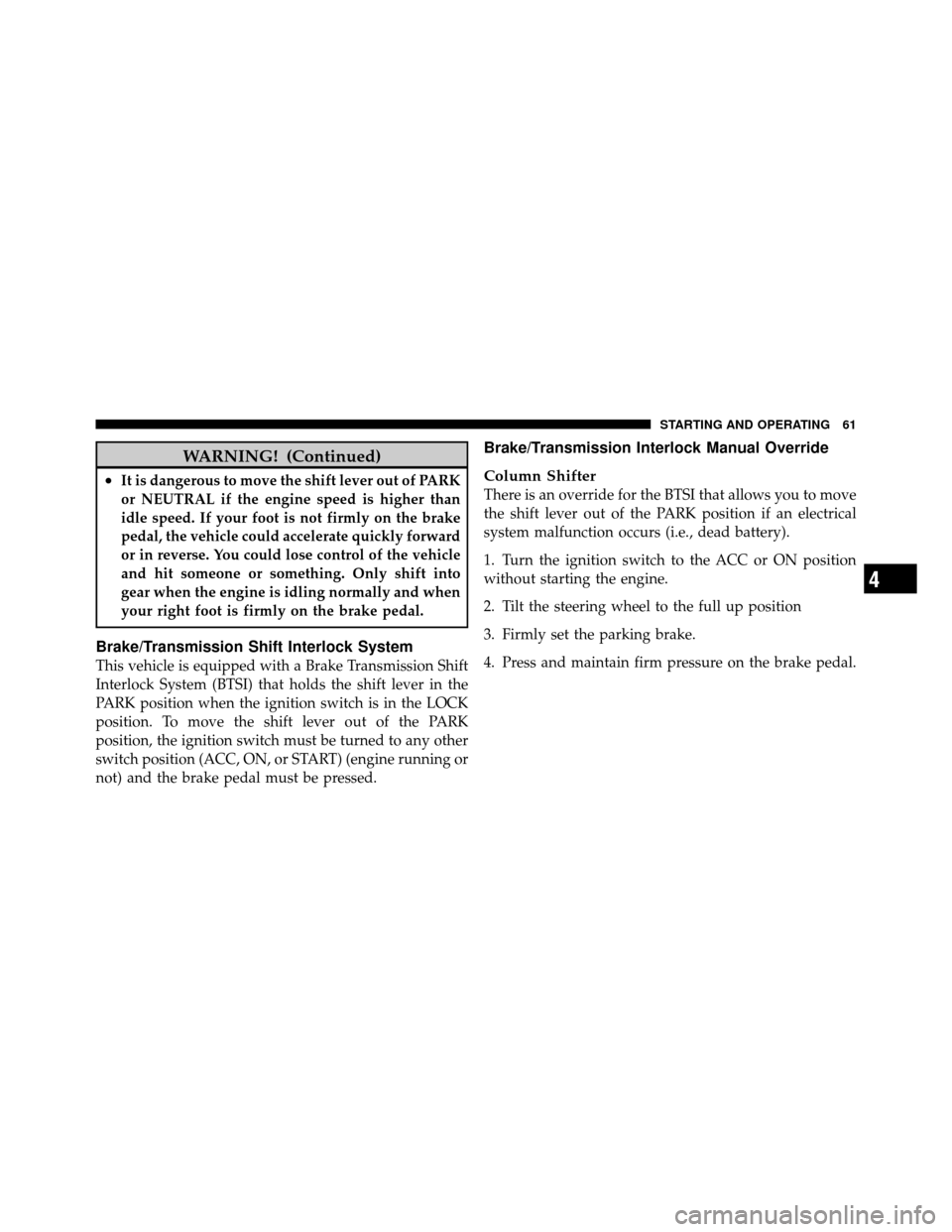Page 62 of 170

WARNING! (Continued)
•It is dangerous to move the shift lever out of PARK
or NEUTRAL if the engine speed is higher than
idle speed. If your foot is not firmly on the brake
pedal, the vehicle could accelerate quickly forward
or in reverse. You could lose control of the vehicle
and hit someone or something. Only shift into
gear when the engine is idling normally and when
your right foot is firmly on the brake pedal.
Brake/Transmission Shift Interlock System
This vehicle is equipped with a Brake Transmission Shift
Interlock System (BTSI) that holds the shift lever in the
PARK position when the ignition switch is in the LOCK
position. To move the shift lever out of the PARK
position, the ignition switch must be turned to any other
switch position (ACC, ON, or START) (engine running or
not) and the brake pedal must be pressed.
Brake/Transmission Interlock Manual Override
Column Shifter
There is an override for the BTSI that allows you to move
the shift lever out of the PARK position if an electrical
system malfunction occurs (i.e., dead battery).
1. Turn the ignition switch to the ACC or ON position
without starting the engine.
2. Tilt the steering wheel to the full up position
3. Firmly set the parking brake.
4. Press and maintain firm pressure on the brake pedal.
4
STARTING AND OPERATING 61
Page 63 of 170

5. Using the screwdriver, press and hold the override tab
through the access port (ringed circle) on the bottom of
the steering column.
6. Move the shift lever into the NEUTRAL position.
7. The vehicle may then be started in NEUTRAL.Six-Speed Automatic Transmission with
Overdrive (68RFE) – If Equipped (Ram Truck
Only)
The shift lever display located in the instrument panel
cluster indicates the transmission gear range (the selector
is illuminated for night driving). The shift lever is
mounted on the right side of the steering column. You
must press the brake pedal to pull the shift lever out of
PARK position (Brake Interlock System). To drive, move
the shift lever from PARK or NEUTRAL to the desired
DRIVE position. Pull the shift lever toward you when
shifting into REVERSE or PARK, or when shifting out of
PARK.
Electronic Range Select (ERS) Operation
The Electronic Range Select (ERS) shift control allows
you to move the switch down (-) or up (+) when the
shifter is in the D (Drive) position, allowing the selection
of the desired top gear. For example, if the driver shiftsInterlock Manual Override
62 STARTING AND OPERATING
Page 75 of 170
![Ram 3500 2011 Diesel Supplement NOTE:
•The torque converter clutch will not engage until the
transmission fluid and engine coolant are warm [usu-
ally after 1-3 miles (1.6 - 4.8 km) of driving]. Because
the engine speed is higher Ram 3500 2011 Diesel Supplement NOTE:
•The torque converter clutch will not engage until the
transmission fluid and engine coolant are warm [usu-
ally after 1-3 miles (1.6 - 4.8 km) of driving]. Because
the engine speed is higher](/manual-img/34/12592/w960_12592-74.png)
NOTE:
•The torque converter clutch will not engage until the
transmission fluid and engine coolant are warm [usu-
ally after 1-3 miles (1.6 - 4.8 km) of driving]. Because
the engine speed is higher when the torque converter
clutch is not engaged, it may seem as if the transmis-
sion is not shifting into Overdrive when cold. This is
normal. Pressing the “TOW/HAUL” switch when the
transmission is sufficiently warm will demonstrate
that the transmission is able to shift into and out of
Overdrive.
•If the vehicle has not been driven in several days, the
first few seconds of operation after shifting the trans-
mission into gear may seem sluggish. This is due to the
fluid partially draining from the torque converter into
the transmission. This condition is normal and will not
cause damage to the transmission. The torque con-
verter will refill within five seconds of shifting from
PARK into any other gear position.
MANUAL TRANSMISSION — IF EQUIPPED
WARNING!
You or others could be injured if you leave the
vehicle unattended without having the parking
brake fully applied. The parking brake should al-
ways be applied when the driver is not in the vehicle,
especially on an incline.
CAUTION!
Never drive with your foot resting on the clutch
pedal, or attempt to hold the vehicle on a hill with the
clutch pedal partially engaged, as this will cause
abnormal wear on the clutch.
NOTE: During cold weather, you may experience in-
creased effort in shifting until the transmission fluid
warms up. This is normal.
74 STARTING AND OPERATING
Page 76 of 170

Shifting
Truck models with manual transmission are equipped
with a clutch interlocking ignition system. The clutch
pedal must be fully pressed to start the vehicle.Fully press the clutch pedal before shifting gears. As you
release the clutch pedal, lightly press the accelerator
pedal.
This transmission has a “creeper” first gear (L=Low)
which should be used to start from a standing position
when carrying a payload or towing a trailer. Damage to
the clutch can result from starting in second or third gear
with a loaded vehicle. An unloaded vehicle may be
launched in second gear. Use each gear in numerical
order – do not skip a gear.
You should use first gear when starting from a standing
position if under heavy load or when pulling a trailer.Recommended Vehicle Shift Speeds
To utilize your manual transmission efficiently for both
fuel economy and performance, it should be upshifted as
listed in recommended shift speed chart. Shift at the
Shift Pattern
4
STARTING AND OPERATING 75
Page 79 of 170

POWER TAKE OFF OPERATION — IF EQUIPPED
(CHASSIS CAB ONLY)
This vehicle when equipped with either the AS68RC
automatic six-speed or G-56 manual six-speed transmis-
sions, will allow for an aftermarket upfit with a transmis-
sion driven PTO (power take off). The customer will have
the ability to operate the PTO in either a “stationary” or
“mobile” mode. The vehicles will be factory set to the
“stationary” mode. In order to select the “mobile” mode
an authorized dealership is required to modify the vehi-
cle’s settings using their proprietary authorized dealer
service tool.
AS68RC Six-Speed Automatic Transmission Only
The PTO drive gear (part of the AS68RC) operates at
torque converter turbine speed. The turbine speed will be
less than engine speed when the torque converter clutch
is not engaged and will be same as engine speed when
the torque converter clutch is engaged.
Stationary Mode
To operate the PTO in this mode the vehicle must meet
the following conditions:
•Be in PARK position (vehicles equipped with auto-
matic transmission)
•Upfitter provider (on/off) switch has been activated
•Parking brake applied (vehicles equipped with
manual transmission)
•Brake pedal must not be applied
•Vehicle engine must be running
•No vehicle, brake or clutch switch faults present
•PTO must be correctly installed using the vehicle
provided circuits
78 STARTING AND OPERATING
Page 91 of 170

JUMP STARTING
WARNING!
•To prevent personal injury or damage to clothing,
do not allow battery fluid to contact eyes, skin or
fabrics. Do not lean over a battery when connect-
ing jumper cables or allow cable clamps to touch
each other. Keep open flames or sparks away from
battery vent holes. Always wear eye protection
when working with batteries.
•Do not use a booster battery or any other booster
source that has a greater than 12 Volt system, i.e.,
do not use a 24 Volt power source.NOTE:
Replacement batteries should both be of equal
size to prevent damage to the vehicle’s charging system.
Your vehicle is equipped with two 12 Volt batteries. If it
becomes necessary to use a booster battery with jumper
cables to start a vehicle’s engine because its batteries are
discharged, the following procedure should be used:
Set the parking brake and place an automatic transmis-
sion in PARK (or NEUTRAL for a manual transmission).
Turn off lights, heater and other electrical loads. Observe
charge indicator (if equipped) in both batteries. If the
indicator (if equipped) is light or yellow on either battery,
replace that battery.
90 WHAT TO DO IN EMERGENCIES
Page 96 of 170
MAINTAINING YOUR VEHICLE
CONTENTS
�Engine Compartment — 6.7L Diesel ......... 97
� Maintenance Procedures .................. 98
▫ Engine Oil .......................... 98
▫ Engine Air Cleaner Filter ............... 102
▫ Draining Fuel/Water Separator Filter ...... 104
▫ Priming If The Engine Has Run Out Of
Fuel .............................. 108
▫ Intervention Regeneration Strategy – EVIC
Message Process Flow ................. 109
▫ Diesel Exhaust Fluid – Chassis Cab Only . . . 112 ▫
Maintenance-Free Batteries ............. 112
▫ Cooling System ..................... 113
▫ Charge Air Cooler – Inter-Cooler ......... 119
▫ Brake System ....................... 119
▫ Clutch Hydraulic System ............... 121
▫ Transfer Case – If Equipped ............. 121
▫ Manual Transmission – If Equipped ....... 121
▫ Automatic Transmission – If Equipped ..... 122
▫ Noise Control System Required Maintenance
& Warranty ........................ 125
6
Page 98 of 170
ENGINE COMPARTMENT — 6.7L DIESEL
1 — Battery7 — Engine Oil Dipstick
2 — Engine Coolant Reservoir 8 — Washer Fluid Reservoir
3 — Automatic Transmission Dipstick (If Equipped) 9 — Engine Oil Fill
4 — Brake Fluid Reservoir 10 — Coolant Pressure Cap
5 — Clutch Master Cylinder (Manual Transmission Only) 11 — Air Cleaner Filter
6 — Integrated Power Module
6
MAINTAINING YOUR VEHICLE 97